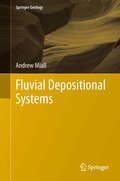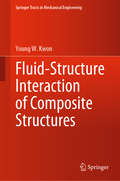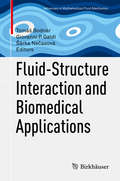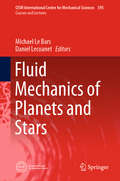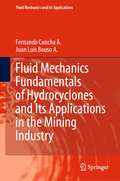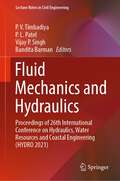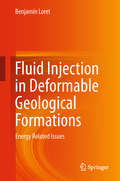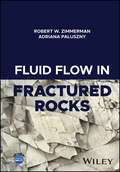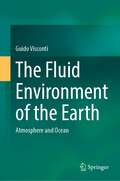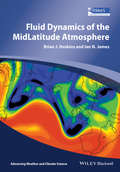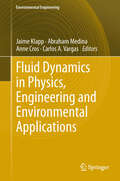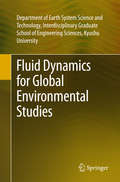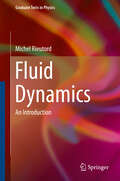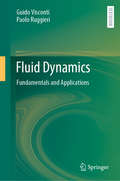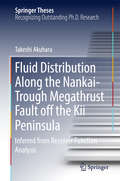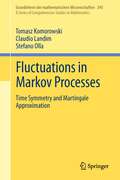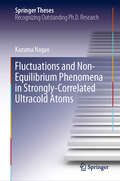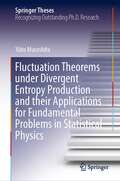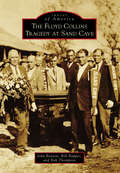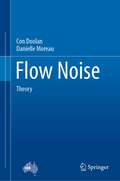- Table View
- List View
Fluvial Depositional Systems: Continuing Education Course Notes 20 (Springer Geology)
by Andrew MiallThis book is intended to complement the author's 1996 book "The geology of fluvial deposits", not to replace it.The book summarizes methods of mapping and interpretation of fluvial depositional systems, with a detailed treatment of the tectonic, climatic and eustatic controls on fluvial depositional processes. It focuses on the preserved, ancient depositional record and emphasizes large-scale (basin-scale) depositional processes. Tectonic and climatic controls of fluvial sedimentation and the effects of base-level change on sequence architecture are discussed. Profusely illustrated and with an extensive reference to the recent literature, this book will be welcomed by the student and professional geologist alike.
Fluid-Structure Interaction of Composite Structures (Springer Tracts in Mechanical Engineering)
by Young W. KwonThis is the first book presenting dynamic responses and failure of polymer composite structures as they interact with internal and/or external fluid media. It summarizes authoritative research carried out by the author in the past decade on various aspects of Fluid-Structure Interaction (FSI) to present important effects of FSI on composite structures. The topics include impact loading on composite structures with air-back, water-back, or containing water; FSI effects on frequencies, mode shapes, and modal curvatures; cyclic loading for fatigue failure with FSI; coupling of independent composite structures by fluid media; and moving composite structures in water. Numerical techniques for FSI are also presented. Research was conducted both experimentally and numerically to complement each other. The book offers a timely, comprehensive information to fluid-structure interaction of composite structures for students, researchers or practicing engineers.
Fluid-Structure Interaction and Biomedical Applications
by Tomáš Bodnár Giovanni P. Galdi Šárka NečasováThis book presents, in a methodical way, updated and comprehensive descriptions and analyses of some of the most relevant problems in the context of fluid-structure interaction (FSI). Generally speaking, FSI is among the most popular and intriguing problems in applied sciences and includes industrial as well as biological applications. Various fundamental aspects of FSI are addressed from different perspectives, with a focus on biomedical applications. More specifically, the book presents a mathematical analysis of basic questions like the well-posedness of the relevant initial and boundary value problems, as well as the modeling and the numerical simulation of a number of fundamental phenomena related to human biology. These latter research topics include blood flow in arteries and veins, blood coagulation and speech modeling. We believe that the variety of the topics discussed, along with the different approaches used to address and solve the corresponding problems, will help readers to develop a more holistic view of the latest findings on the subject, and of the relevant open questions. For the same reason we expect the book to become a trusted companion for researchers from diverse disciplines, such as mathematics, physics, mathematical biology, bioengineering and medicine.
Fluid Mechanics of Planets and Stars (CISM International Centre for Mechanical Sciences #595)
by Michael Le Bars Daniel LecoanetThis book explores the dynamics of planetary and stellar fluid layers, including atmospheres, oceans, iron cores, and convective and radiative zones in stars, describing the different theoretical, computational and experimental methods used to study these problems in fluid mechanics, including the advantages and limitations of each method for different problems. This scientific domain is by nature interdisciplinary and multi-method, but while much effort has been devoted to solving open questions within the various fields of mechanics, applied mathematics, physics, earth sciences and astrophysics, and while much progress has been made within each domain using theoretical, numerical and experimental approaches, cross-fertilizations have remained marginal. Going beyond the state of the art, the book provides readers with a global introduction and an up-to-date overview of relevant studies, fully addressing the wide range of disciplines and methods involved. The content builds on the CISM course “Fluid mechanics of planets and stars”, held in April 2018, which was part of the research project FLUDYCO, supported by the European Research Council (ERC) under the European Union's Horizon 2020 research and innovation program.
Fluid Mechanics Fundamentals of Hydrocyclones and Its Applications in the Mining Industry (Fluid Mechanics and Its Applications #126)
by Fernando Concha A. Juan Luis Bouso A.This book covers topics on engineering science, technology and applications of the classification of particles in liquids suspensions in hydrocyclones. It is divided into 12 chapters starting with the introduction of the hydrocyclone to the mining industry and its several applications of classification, followed by the fundamentals of classification. A special chapter on the fundamentals of sedimentation as the mechanism of the hydrocyclone classification is given. The authors also cover the fundamentals hydrodynamics of solid–fluid interaction with application to the fluids and suspensions flow of in circular pipelines and discusses the flow pattern in hydrocyclones from a fluid dynamics point of view. The physical design, the empirical, phenomenological and numerical hydrocyclone models are presented. The two last chapters deal with the applications of hydrocyclones system design and instrumentation study cases of application in hydrocyclones to the mining industry. Several parts of this book are the result of the work of their research and professional groups from the university and industry.
Fluid Mechanics and Hydraulics: Proceedings of 26th International Conference on Hydraulics, Water Resources and Coastal Engineering (HYDRO 2021) (Lecture Notes in Civil Engineering #314)
by P. V. Timbadiya P. L. Patel Vijay P. Singh Bandita BarmanThis book comprises the proceedings of the 26th International Conference on Hydraulics, Water Resources and Coastal Engineering (HYDRO 2021) focusing on broad spectrum of emerging opportunities and challenges in the field of fluid mechanics and hydraulics. It covers a range of topics, including, but not limited to, experimental and computational fluid mechanics, sediment dynamics, environmental impact assessment of water resources projects, environmental flows, pollutant transport, etc. Presenting recent advances in the form of illustrations, tables, and text, it offers readers insights for their own research. In addition, the book addresses fundamental concepts and studies in the field of flood forecasting and hydraulic structures, making it a valuable resource for both beginners and researchers wanting to further their understanding of hydraulics, water resources and coastal engineering.
Fluid Injection in Deformable Geological Formations: Energy Related Issues
by Benjamin LoretThis book offers an introduction to the geomechanical issues raised by both the extraction of actual and potential energy resources, and by the treatment of the ensuing environmental concerns. Discussions of the operations of injection of fluids into, and withdrawal from, geological formations link the chapters, each devoted to a particular technical aspect or scientific issue, or to a particular energy resource.Subjects are ordered according to their industrial applications, including enhanced oil and gas recovery, gas hydrates, enhanced geothermal systems, hydraulic fracturing, and carbon dioxide sequestration. An overview of the industrial, research and simulation aspects for each subject is provided. Fluid Injection in Deformable Geological Formations will be of interest to academic and industrial researchers in a wide variety of fields, including computational mechanics, civil engineering, geotechnical engineering and geomechanics, engineering seismology, petroleum engineering, reservoir engineering, and engineering geology.
Fluid-Induced Seismicity
by Serge A. ShapiroThe characterisation of fluid transport properties of rocks is one of the most important, yet difficult, challenges of reservoir geophysics, but is essential for optimal development of hydrocarbon and geothermal reservoirs. This book provides a quantitative introduction to the underlying physics, application, interpretation, and hazard aspects of fluid-induced seismicity with a particular focus on its spatio-temporal dynamics. It presents many real data examples of microseismic monitoring of hydraulic fracturing at hydrocarbon fields and of stimulations of enhanced geothermal systems. The author also covers introductory aspects of linear elasticity and poroelasticity theory, as well as elements of seismic rock physics and mechanics of earthquakes, enabling readers to develop a comprehensive understanding of the field. Fluid-Induced Seismicity is a valuable reference for researchers and graduate students working in the fields of geophysics, geology, geomechanics and petrophysics, and a practical guide for petroleum geoscientists and engineers working in the energy industry.
Fluid Flow in Fractured Rocks
by Robert W. Zimmerman Adriana PalusznyFLUID FLOW IN FRACTURED ROCKS "The definitive treatise on the subject for many years to come" (Prof. Ruben Juanes, MIT) Authoritative textbook that provides a comprehensive and up-to-date introduction to fluid flow in fractured rocks Fluid Flow in Fractured Rocks provides an authoritative introduction to the topic of fluid flow through single rock fractures and fractured rock masses. This book is intended for readers with interests in hydrogeology, hydrology, water resources, structural geology, reservoir engineering, underground waste disposal, or other fields that involve the flow of fluids through fractured rock masses. Classical and established models and data are presented and carefully explained, and recent computational methodologies and results are also covered. Each chapter includes numerous graphs, schematic diagrams and field photographs, an extensive reference list, and a set of problems, thus providing a comprehensive learning experience that is both mathematically rigorous and accessible. Written by two internationally recognized leaders in the field, Fluid Flow in Fractured Rocks includes information on: Nucleation and growth of fractures in rock, with a multiscale characterization of their geometric traits Effect of normal and shear stresses on the transmissivity of a rock fracture and mathematics of fluid flow through a single rock fracture Solute transport in rocks, with quantitative descriptions of advection, molecular diffusion, and dispersion Fluid Flow in Fractured Rocks is an essential resource for researchers and postgraduate students who are interested in the field of fluid flow through fractured rocks. The text is also highly suitable for professionals working in civil, environmental, and petroleum engineering.
The Fluid Environment of the Earth: Atmosphere and Ocean
by Guido ViscontiThe book is conceived at two levels. An introductory one intended for undergraduate and/or environmental studies students and the other (in the appendix) for advanced students (graduate). The book is different from others on the same subject which are either too descriptive or too much specialized. Beside there are large sections on biogeochemistry not usually found in other textbooks. Whenever possible an approach based on entropy considerations is introduced. The book includes a quite classical introduction to the thermodynamics of ocean and atmosphere, then the circulation of the ocean and atmosphere, the connection climate-chemistry with main emphasis on the carbon dioxide problem. The chemistry is also considered in connection with the polluted atmosphere and ocean and particulate in the atmosphere . A chapter is dedicated to the biogeochemical cycles which are solved both with the integration of a system of equations or matrix algebra. An original chapter is dedicated to sea-atmosphere interactions which includes the monsoons meteorology, hurricanes and the ENSO phenomena. Finally a concise description of the fluid environments in the Solar System is given.
Fluid Dynamics of the Mid-Latitude Atmosphere (Advancing Weather and Climate Science)
by Brian J. Hoskins Ian N. JamesThis book gives a coherent development of the current understanding of the fluid dynamics of the middle latitude atmosphere. It is primarily aimed at post-graduate and advanced undergraduate level students and does not assume any previous knowledge of fluid mechanics, meteorology or atmospheric science. The book will be an invaluable resource for any quantitative atmospheric scientist who wishes to increase their understanding of the subject. The importance of the rotation of the Earth and the stable stratification of its atmosphere, with their implications for the balance of larger-scale flows, is highlighted throughout.Clearly structured throughout, the first of three themes deals with the development of the basic equations for an atmosphere on a rotating, spherical planet and discusses scale analyses of these equations. The second theme explores the importance of rotation and introduces vorticity and potential vorticity, as well as turbulence. In the third theme, the concepts developed in the first two themes are used to give an understanding of balanced motion in real atmospheric phenomena. It starts with quasi-geostrophic theory and moves on to linear and nonlinear theories for mid-latitude weather systems and their fronts. The potential vorticity perspective on weather systems is highlighted with a discussion of the Rossby wave propagation and potential vorticity mixing covered in the final chapter.
Fluid Dynamics in Physics, Engineering and Environmental Applications
by Abraham Medina Anne Cros Carlos A. Vargas Jaime KlappThe book contains invited lectures and selected contributions presented at the Enzo Levi and XVII Annual Meeting of the Fluid Dynamic Division of the Mexican Physical Society in 2011. It is aimed to fourth year undergraduate and graduate students, and scientists in the field of physics, engineering and chemistry that have interest in Fluid Dynamics from the experimental and theoretical point of view. The invited lectures are introductory and avoid the use of complicate mathematics. The other selected contributions are also adequate to fourth year undergraduate and graduate students. The Fluid Dynamics applications include multiphase flow, convection, diffusion, heat transfer, rheology, granular material, viscous flow, porous media flow, geophysics and astrophysics. The material contained in the book includes recent advances in experimental and theoretical fluid dynamics and is adequate for both teaching and research.
Fluid Dynamics for Global Environmental Studies
by Kyushu Univ. Interdis.Grad Sch Engg Sci Dept. Earth Sys Sci. Tech.This book introduces the basic concepts of environmental fluid dynamics. It is intended for use by students, researchers, engineers, and specialists working not only in general fluid research but also in the atmospheric and oceanic research fields. The Earth is covered by atmosphere and oceans and is exposed to solar wind. Therefore, the knowledge of fluid dynamics is essential for tackling its environmental issues. Although many textbooks have treated fluid dynamics, practically no book has been published that clearly describes all essential ideas, from the fundamentals of fluid dynamics to advanced environmental sciences, with careful sequential explanations of the governing mathematics. This book has been developed to solve these educational problems and has actually been in use in lectures in the graduate school of Kyushu University for more than 15 years.
Fluid Dynamics: An Introduction (Graduate Texts in Physics)
by Michel RieutordThis book is dedicated to readers who want to learn fluid dynamics from the beginning. It assumes a basic level of mathematics knowledge that would correspond to that of most second-year undergraduate physics students and examines fluid dynamics from a physicist’s perspective. As such, the examples used primarily come from our environment on Earth and, where possible, from astrophysics. The text is arranged in a progressive and educational format, aimed at leading readers from the simplest basics to more complex matters like turbulence and magnetohydrodynamics. Exercises at the end of each chapter help readers to test their understanding of the subject (solutions are provided at the end of the book), and a special chapter is devoted to introducing selected aspects of mathematics that beginners may not be familiar with, so as to make the book self-contained.
Fluid Dynamics: Fundamentals and Applications
by Guido Visconti Paolo RuggieriThis introductory book addresses a broad range of classical Fluid Dynamics topics, interesting applications, and related problems in everyday life. The geophysical and astrophysical applications discussed concern e.g. the shape and internal structure of the Earth and stars, the dynamics of the atmosphere and ocean, hydrodynamic instabilities, and the different kinds of waves that can be found in the atmosphere, ocean and solid Earth. Non-linear waves (solitons) are also mentioned. In turn, the book explores problems from everyday life, including the motion of golf balls, life at low Reynolds numbers, the physics of sailing, and the aerodynamics of airplanes and Grand Prix cars. No book on this topic would be complete without a look at chaos and turbulence; here the problems span from Gaussian plumes to chaotic dynamos, to stochastic climate modeling. Advances in fluid dynamics have produced a wealth of numerical methods and techniques, which are used in many of the applications. Given its structure, the book can be used both for an introductory course to fluid dynamics and as preparation for more advanced problems typical of graduate-level courses.
Fluid Distribution Along the Nankai-Trough Megathrust Fault off the Kii Peninsula: Inferred From Receiver Function Analysis (Springer Theses)
by Takeshi AkuharaThis thesis explores fluid distribution along the Nankai-Trough megathrust fault around the Kii Peninsula of Japan, where devastating earthquakes are expected to occur in the near future. Exploring fluid distribution along subduction zones is an important issue because the fluid is considered to control the occurrence of earthquakes. One of the effective strategies to estimate fluid content is retrieving receiver functions (RFs) from seismograms, but in the case of ocean-bottom seismometers (OBSs), noisy P-wave reverberations within the seawater column make such an analysis difficult. The author therefore developed a novel technique to suppress the water reverberations, which allows obtaining the fluid distribution data along a wide depth range on the plate interface. This thesis first presents the new technique, called the water layer filter method, and demonstrates its efficiency by using both synthetic and observation data. Then, using the method, a receiver function image of the Philippine Sea Plate is constructed to reveal dehydration processes of the subducting oceanic crust around the Kii Peninsula. Finally, the author performs high-frequency receiver function inversion analysis. The results indicate the presence of a thin fluid-rich sediment layer along the megathrust fault off the Kii Peninsula that acts as a pathway of fluid. Nowadays, the number of offshore observations is increasing worldwide. In this respect, the attempt to better analyze OBS data employing the new method will become more important in future studies.
Fluctuations in Markov Processes
by Claudio Landim Stefano Olla Tomasz KomorowskiThe present volume contains the most advanced theories on the martingale approach to central limit theorems. Using the time symmetry properties of the Markov processes, the book develops the techniques that allow us to deal with infinite dimensional models that appear in statistical mechanics and engineering (interacting particle systems, homogenization in random environments, and diffusion in turbulent flows, to mention just a few applications). The first part contains a detailed exposition of the method, and can be used as a text for graduate courses. The second concerns application to exclusion processes, in which the duality methods are fully exploited. The third part is about the homogenization of diffusions in random fields, including passive tracers in turbulent flows (including the superdiffusive behavior). There are no other books in the mathematical literature that deal with this kind of approach to the problem of the central limit theorem. Hence, this volume meets the demand for a monograph on this powerful approach, now widely used in many areas of probability and mathematical physics. The book also covers the connections with and application to hydrodynamic limits and homogenization theory, so besides probability researchers it will also be of interest also to mathematical physicists and analysts.
Fluctuations and Non-Equilibrium Phenomena in Strongly-Correlated Ultracold Atoms (Springer Theses)
by Kazuma NagaoThis book discusses non-equilibrium quantum many-body dynamics, recently explored in an analog quantum simulator of strongly correlated ultracold atoms. The first part presents a field-theoretical analysis of the experimental observability of the Higgs amplitude mode that emerges as a relativistic collective excitation near a quantum phase transition of superfluid Bose gases in an optical lattice potential. The author presents the dynamical susceptibilities to external driving of the microscopic parameters, taking into account a leading-order perturbative correction from quantum and thermal fluctuations and shows clear signatures of the Higgs mode in these observables. This is the first result that strongly supports the stability of the Higgs mode in three-dimensional optical lattices even in the presence of a spatially inhomogeneous confinement potential and paves the way for desktop observations of the Higgs mode. In the second part, the author applies the semi-classical truncated-Wigner approximation (TWA) to far-from-equilibrium quantum dynamics. Specifically, he considers the recent experiments on quantum-quench dynamics in a Bose-Hubbard quantum simulator. A direct comparison shows remarkable agreement between the numerical results from TWA and the experimental data. This result clearly indicates the potential of such a semi-classical approach in reliably simulating many-body systems using classical computers. The book also includes several chapters providing comprehensive reviews of the recent studies on cold-atomic quantum simulation and various theoretical methods, including the Schwinger-boson approach in strongly correlated systems and the phase-space semi-classical method for far-from-equilibrium quantum dynamics. These chapters are highly recommended to students and young researchers who are interested in semi-classical approaches in non-equilibrium quantum dynamics.
Fluctuation Theorems under Divergent Entropy Production and their Applications for Fundamental Problems in Statistical Physics (Springer Theses)
by Yûto MurashitaThis book presents the derivation of the fluctuation theorems with divergent entropy production and their application to fundamental problems in statistical physics. It explores the two basic aspects of the fluctuation theorems: i) Applicability in extreme situations with divergent entropy production, concluding that the fluctuation theorems remain valid under the notion of absolute irreversibility, and ii) utility in the investigation of classical enigmas in the framework of statistical physics, i.e., Gibbs and Loschmidt paradoxes. The book offers readers an overview of the research in fundamental statistical physics. Firstly it briefly but skillfully reviews the modern development of fluctuation theorems to found the key theme of the book. Secondly it concisely discusses historical issues of statistical physics in chronological order, along with the key literature in the field. They help readers easily follow the key developments in the fundamental research of statistical physics.
The Floyd Collins Tragedy at Sand Cave (Images of America)
by John Benton Bob Thompson Bill NapperFloyd Collins is perhaps the most famous person you have probably never heard of. Collins was a Kentucky cave explorer who was trapped for more than two weeks during the winter of 1925 in a cave located within the boundaries of what is now Mammoth Cave National Park. Collins had no fear of exploring the most difficult cave passages, and few people could match his persistence and endurance. The story of Floyd Collins becoming trapped, then buried alive, and ultimately dying alone in a cave held a powerful grip on the hearts and minds of people the world over. The resulting media coverage put Mammoth Cave on the map and helped usher the actual designation of Mammoth Cave as a national park. His explorations laid the foundation for others to later discover that Mammoth Cave was the longest cave in the world.
Flowers that Fly
by Susan Yoder AckermanSimon teaches his little cousin Adeline about how to grow a garden that will attract beautiful butterflies.
A Flower Garden for Pollinators: Learn how to sustain and support nature with this practical planting guide
by Rachel de ThameThe perfect guide for any gardener looking for inspiration on how to create a pollinator-friendly garden all year round.Pollinators are essential to life on Earth. Yet bees, butterflies and other beneficial insects are struggling due to climate change and habit loss. Fortunately, what we choose to plant in our gardens can help them to thrive. In this heartfelt guide, horticulturalist and Gardener's World presenter Rachel de Thame highlights plants we can grow that are rich in nectar and pollen, ensuring the garden is filled with beautiful flowers for us all to enjoy year-round.Arranged by season and illustrated with exquisite hand-painted watercolours and glorious photography showcasing many of Rachel's favourite plants, this book provides a captivating look at how best to support nature. Whether you have a small urban courtyard or a large country garden, A Flower Garden for Pollinators will guide your choice of plants, attracting a host of pollinators to your own patch of paradise.'A wonderful journey through the magical world of plants.' - Frances Tophill
A Flower Garden for Pollinators: Learn how to sustain and support nature with this practical planting guide
by Rachel de ThameThe perfect guide for any gardener looking for inspiration on how to create a pollinator-friendly garden all year round.Pollinators are essential to life on Earth. Yet bees, butterflies and other beneficial insects are struggling due to climate change and habit loss. Fortunately, what we choose to plant in our gardens can help them to thrive. In this heartfelt guide, horticulturalist and Gardener's World presenter Rachel de Thame highlights plants we can grow that are rich in nectar and pollen, ensuring the garden is filled with beautiful flowers for us all to enjoy year-round.Arranged by season and illustrated with exquisite hand-painted watercolours and glorious photography showcasing many of Rachel's favourite plants, this book provides a captivating look at how best to support nature. Whether you have a small urban courtyard or a large country garden, A Flower Garden for Pollinators will guide your choice of plants, attracting a host of pollinators to your own patch of paradise.'A wonderful journey through the magical world of plants.' - Frances Tophill
Flow Through Heterogeneous Geologic Media
by Yeh, Tian-Chyi “Jim” and Khaleel, Raziuddin and Carroll, Kenneth C. Yeh, Tian-Chyi “Jim” Raziuddin Khaleel Kenneth C. CarrollThis textbook integrates classic principles of flow through porous media with recently developed stochastic analyses to provide new insight on subsurface hydrology. Importantly, each of the authors has extensive experience in both academia and the world of applied groundwater hydrology. The book not only presents theories but also emphasizes their underlying assumptions, limitations, and the potential pitfalls that may occur as a result of blind application of the theories as 'cookie-cutter' solutions. The book has been developed for advanced-level courses on groundwater fluid flow, hydraulics, and hydrogeology, in either civil and environmental engineering or geoscience departments. It is also a valuable reference text for researchers and professionals in civil and environmental engineering, geology, soil science, environmental science, and petroleum and mining engineering.
Flow Noise: Theory
by Con Doolan Danielle MoreauThis book highlights the importance of sound produced by fluid flow or flow-induced noise. Noise created by unsteady flow creates high levels of environmental noise pollution, a known public health problem, and can compromise the acoustic qualities of marine vessels. There is a seemingly ever-growing list of modern technology that created flow-induced noise which includes aircraft, wind turbines, submarines, drones, high-speed rail, and cooling fans. More scientists and engineers are required to incorporate the effects of flow-induced noise in their work. This book also provides a comprehensive introduction to the theory underpinning the understanding of flow-induced noise.
